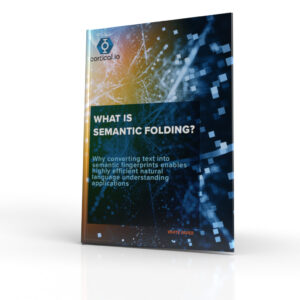A Game-Changing Approach
To Natural Language Processing
Proven Approach to AI
Inspired by the way the brain processes information
Highly Accurate
Understands the meaning of words in their context, independently of keywords
Highly Efficient
Requires less training data and processes large amounts of text quicker than LLMs
Flexible & Transparent
Applicable to any language & easily inspectable
+ GDPR-compliant
Biologically-Inspired Natural Language Processing (NLP)
Inspired by neuroscience, Semantic Folding is a machine learning methodology for creating language models with small amounts of training data compared to Large Language Models (LLMs).
With Semantic Folding, text is converted into a new data representation called a semantic fingerprint. Semantic fingerprints capture the different meanings of words based on thousands of parameters and form clusters of similar contexts. For document processing tasks like classification and semantic search, the system just needs to measure semantic overlaps between semantic fingerprints – a highly efficient computational approach that delivers accurate results with less computing resources than LLMs.
Semantic Folding is a real differentiator for natural language processing as it enables a unique combination of high accuracy, efficiency, flexibility and transparency.
What is Semantic Folding?
High Efficiency Natural Language Processing
Meaning-Based Algorithm Delivers High Accuracy
Semantic fingerprints leverage 16k parameters to encapsulate the different meanings of words, sentences or paragraphs. This enables to disambiguate text at a fine-grained level and to match phrases that have similar meanings but different phrasing. As a result, companies get fewer false positives and require less manual intervention to review and correct results.
Semantic Folding Enables Highly Efficient Natural Language Processing
Language models based on semantic fingerprints need orders of magnitude less annotated examples than Transformer models to reach comparable levels of accuracy (a few hundreds versus several thousands). This means that companies get actionable results much quicker, and with less human resources involved.
Semantic fingerprints are sparse distributed vectors that require much less computing power than LLMs to process large amounts of text. Applications leveraging Semantic Folding do not only save IT costs, they also contribute to lower the carbon footprint of IT operations.
Inspect Results At The Press Of A Button
With Semantic Folding, it is easy to debug and fine-tune language models because each semantic feature can be inspected at the document level. This aspect also guarantees the full transparency and explainability of results, enabling enterprises to eliminate biases in their models and to meet compliance requirements (e.g. GDPR).
Natural Language Processing That Scales
Semantic Folding empowers business users to customize and train their models with comparatively little example documents. As a result, companies can implement a NLP project where only little training data exist, and easily scale it to other use cases and departments within the enterprise without the need for dedicated, internal AI expertise.
Semantic Folding can be applied to any language and enables direct cross-language NLP, so that translation efforts become obsolete.
Advantages of Semantic Folding
High Accuracy
Semantic fingerprints leverage a rich semantic feature set of 16k parameters, enabling a fine-grained disambiguation of words and concepts.
High Efficiency
Semantic Folding requires order of magnitude less training material (100s vs, 1’000s) and less compute resources because it uses sparse distributed vectors.
High Transparency & Explainability
Each semantic feature can be inspected at the document level so that biases can be eliminated in the models and results explained.
High Flexibility & Scalability
Semantic Folding can be applied to any language and use case, and business users can easily customize models.
ChatGPT and LLMs:
The Holy Grail of Enterprise AI?

Explore Semantic Folding

By Xavier Gigandet et. al. – Gigandet X, Hagmann P, Kurant M, Cammoun L, Meuli R, et al. (2008) Estimating the Confidence Level of White Matter Connections Obtained with MRI Tractography. PLoS ONE 3(12): e4006. doi:10.1371/journal.pone.0004006, CC BY 2.5, https://commons.wikimedia.org/w/index.php?curid=8134159
By Hagmann P, Cammoun L, Gigandet X, Meuli R, Honey CJ, Wedeen VJ, Sporns O – Hagmann P, Cammoun L, Gigandet X, Meuli R, Honey CJ, Wedeen VJ, Sporns O (2008) Mapping the structural core of human cerebral cortex. PLoS Biology Vol. 6, No. 7, e159.[1], CC BY 3.0, https://commons.wikimedia.org/w/index.php?curid=6246097